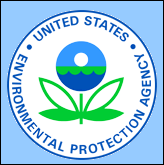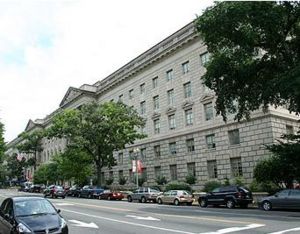U.S. Environmental Protection Agency: Difference between revisions
imported>Milton Beychok m (Added a section) |
imported>Milton Beychok m (→Air Quality Modeling Group: Minor spacing change) |
||
| Line 64: | Line 64: | ||
== Air Quality Modeling Group == | == Air Quality Modeling Group == | ||
{{main|Air Quality Modeling Group}} | {{main|Air Quality Modeling Group}} | ||
The Air Quality Modeling Group (AQMG) is part of the Office of Air Quality Planning and Standards in the U.S. EPA's Office of Air and Radiation (OAR) and provides leadership and direction on the full range of air quality models, air pollution dispersion models and other mathematical simulation techniques used in assessing pollution control strategies and the impacts of air pollution sources. | The Air Quality Modeling Group (AQMG) is part of the Office of Air Quality Planning and Standards in the U.S. EPA's Office of Air and Radiation (OAR) and provides leadership and direction on the full range of air quality models, air pollution dispersion models and other mathematical simulation techniques used in assessing pollution control strategies and the impacts of air pollution sources. | ||
Revision as of 18:04, 2 February 2008
The United States Environmental Protection Agency (EPA or U.S. EPA) is an independent agency of the Government of the United States of America created by an act of Congress in 1970 and is part of the executive branch of the government.[2][3] The primary mission of the EPA is to protect human health and safeguard the natural environment (air, water and land) of the nation.[4]
The EPA was established to combine into a single agency many of the existing federal government activities of research and development, monitoring, setting of standards, compliance and enforcement related to protection of the environment.
The EPA has a staff of about 18,000 people in headquarters and departmental or divisional offices, 10 regional offices, and over 25 laboratories located across the nation. More than half of the staff are engineers, scientists and environmental protection specialists. The others include legal counsel, financial, public affairs and computer specialists.
Brief history
President Richard Nixon, on July 9,1970, sent his Reorganization Plan 3 to Congress in which he informed them of his wish to create the EPA by combining parts of three federal Departments, three Bureaus, three Administrations and many other offices into the new single, independent agency to be known as the Environmental Protection agency.[4]
The House of Representatives held hearings on the reorganization plan in the summer of 1970 and largely supported the President's plan. The Senate also held hearings on the plan in July 1970 and also approved the plan.[4]
On December 2, 1970, the EPA was officially established and began operation.
Major laws administered by the EPA
The EPA administers over a dozen major environmental laws including:[6]
- Clean Air Act
- Clean Water Act
- Comprehensive Environmental Response, Compensation, and Liability Act (CERCLA, also known as Superfund) and Superfund Amendments and Reauthorization Act (SARA)
- Emergency Planning & Community Right-to-Know Act
- Federal Insecticide, Fungicide & Rodenticide Act (FIFRA) and Federal Food, Drug, and Cosmetic Act (FFDCA)
- National Environmental Policy Act (NEPA)
- Oil Pollution Act of 1990
- Safe Drinking Water Act
- Solid Waste Disposal Act and Resource Conservation & Recovery Act (RCRA)
- Toxic Substances Control Act (TSCA)
Organization of the EPA
The EPA has a number of departments or divisions as well as ten regional offices:[7]
- Administrator and Deputy Administrator
- Office of the Chief Financial Officer
- Office of the General Counsel
- Office of the Inspector General
- Assistant Administrator for Administration and Resources Management
- Assistant Administrator for Enforcement and Compliance Assurance
- Assistant Administrator for International Affairs
- Assistant Administrator for Environmental Information
- Assistant Administrator for Air and Radiation
- Assistant Administrator for Water
- Assistant Administrator for Prevention, Pesticides and Toxic Substances
- Assistant Administrator for Research and Development
- Assistant Administrator for Solid Waste and Energency Response
- Regional offices[7]
- Region 1 (Boston) Serving Connecticut, Maine, Massachusetts, New Hampshire, Rhode Island, Vermont & 10 Tribal Nations
- Region 2 (New York) Serving New Jersey, New York, Puerto Rico, US Virgin Islands and 7 Tribal Nations
- Region 3 (Philadelphia) Serving Delaware, District of Columbia, Maryland, Pennsylvania, Virginia, and West Virginia
- Region 4 (Atlanta) Serving Alabama, Florida, Georgia, Kentucky, Mississippi, North Carolina, South Carolina, Tennessee and 6 Tribes
- Region 5 (Chicago) Serving Illinois, Indiana, Michigan, Minnesota, Ohio, Wisconsin and 35 Tribes
- Region 6 (Dallas) Serving Louisiana, Arkansas, Oklahoma, New Mexico, Texas and 65 Tribes
- Region 7 (Kansas City) Serving Iowa, Kansas, Missouri, Nebraska and 9 Tribal Nations
- Region 8 (Denver) Serving Colorado, Montana, North Dakota, South Dakota, Utah, Wyoming and 27 Tribal Nations
- Region 9 (San Francisco) Serving Arizona, California, Hawaii, Nevada, the Pacific Islands, and Tribal Nations
- Region 10 (Seattle) Serving Alaska, Idaho, Oregon, Washington and Native Tribes
Air Quality Modeling Group
The Air Quality Modeling Group (AQMG) is part of the Office of Air Quality Planning and Standards in the U.S. EPA's Office of Air and Radiation (OAR) and provides leadership and direction on the full range of air quality models, air pollution dispersion models and other mathematical simulation techniques used in assessing pollution control strategies and the impacts of air pollution sources.
The AQMG is located in Research Triangle Park, North Carolina.
References
- ↑ The EPA Seal
- ↑ Origins of the EPA: An Environmental Revolution]
- ↑ Origins of the EPA: An Agency For The Environment]
- ↑ 4.0 4.1 4.2 EPA History Home
- ↑ The EPA Building
- ↑ Environmental Protection Agency, United States Ralph Stuart, Peter Saundry and Sidney Draggan (Contributing Authors); Richard Reibstein (Topic Editor). 2008. "Environmental Protection Agency, United States." In: Encyclopedia of Earth. Eds. Cutler J. Cleveland (Washington, D.C.: Environmental Information Coalition, National Council for Science and the Environment). [First published in the Encyclopedia of Earth December 6, 2007; Last revised January 9, 2008; Retrieved January 28, 2008].
- ↑ 7.0 7.1 EPA Organizational Structure
- Editable Main Articles with Citable Versions
- CZ Live
- Engineering Workgroup
- Earth Sciences Workgroup
- Politics Workgroup
- Chemical Engineering Subgroup
- Environmental Engineering Subgroup
- Articles written in American English
- Advanced Articles written in American English
- All Content
- Engineering Content
- Earth Sciences Content
- Politics Content
- Chemical Engineering tag
- Environmental Engineering tag

